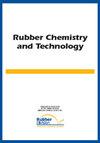三氯异氰尿酸溶液橡胶与聚氨酯胶接面粘接机理的不同探讨
IF 1.5
4区 工程技术
Q4 POLYMER SCIENCE
引用次数: 0
摘要
尽管用三氯异氰尿酸(TCI)的有机溶剂溶液对橡胶进行表面处理所产生的改善与聚氨酯(PU)粘合剂粘附性的效果已经确定,但所涉及的粘附机制仍不清楚。在本研究中,橡胶表面的TCI物种与聚氨酯粘合剂的反应导致化学键的形成,被认为是粘合的相关机制。作为模型,将TCI添加到聚氨酯粘合剂(PU+TCI)中,并将聚氨酯膜浸入TCI溶液(PU−TCI)中,对其表面、结构和粘弹性进行不同时间的监测。在键合形成过程中,聚氨酯链和源自橡胶表面上固体TCI晶体的TCI物质之间形成了化学键,并证明了聚氨酯表面的交联/硬化。与TCI物种的反应增加了聚氨酯的表面能,主要是极性组分,7天后PU+TCI和PU-TCI都获得了相似的表面能。与TCI反应的PU表面能的增强归因于新的C–Cl和C=O物种的产生,它们在PU+TCI上的百分比高于在PU−TCI表面上的百分比。另一方面,产生了新的N–H伸缩和羰基物种;这表明TCI物种与硬段相互作用。此外,在比PU更高的温度和更低的焓下,PU+TCI和PU-TCI中的结晶峰表明软链段之间的相互作用被破坏。因此,与TCI物质反应引起的PU结构变化影响了它们的相分离程度和粘弹性。在PU中加入固体TCI会引起明显的降解和硬化,随着时间的增加,降解程度更加明显,这导致了较低的机械性能。本文章由计算机程序翻译,如有差异,请以英文原文为准。
DIFFERENT APPROACH TO THE MECHANISM OF ADHESION OF SURFACE TREATED WITH TRICHLOROISOCYANURIC ACID SOLUTION RUBBER AND POLYURETHANE ADHESIVE JOINTS
Although the effects produced by the surface treatment of rubber with organic solvent solutions of trichloroisocyanuric acid (TCI) leading to improved adhesion to polyurethane (PU) adhesive have been established, the mechanism of adhesion involved is still unclear. In this study, the reaction of TCI species on the rubber surface with the polyurethane adhesive leading to the formation of chemical bonds was proposed as the relevant mechanism of adhesion. As a model, TCI was added to polyurethane adhesive (PU + TCI), and a polyurethane film was immersed in TCI solution (PU − TCI), their surface, structural, and viscoelastic properties were monitored for different times. The formation of chemical bonds between the polyurethane chains and TCI species derived from the solid TCI crystals on the rubber surface during bonding formation, and the crosslinking/hardening of the polyurethane surface were evidenced. The reaction with TCI species increased the surface energy on the polyurethane, mainly the polar component, similar surface energies were obtained in both PU + TCI and PU − TCI after 7 days. The enhanced surface energies on the PU that reacted with TCI were ascribed to the creation of new C–Cl and C=O species, their percentages were higher on PU + TCI than on PU − TCI surface. On the other hand, new N–H stretching and carbonyl species were produced; this indicated that TCI species interacted with the hard segments. Furthermore, the crystallization peaks in PU + TCI and PU − TCI at higher temperatures and lower enthalpies than in the PU indicated the disruption of the interactions between the soft segments. Therefore, the structural changes in the PU caused by reaction with TCI species affected their degree of phase separation and viscoelastic properties. The addition of solid TCI to the PU caused a noticeable degradation and hardening, the extent of degradation was more marked by increasing the time, this led to lower mechanical properties.
求助全文
通过发布文献求助,成功后即可免费获取论文全文。
去求助
来源期刊

Rubber Chemistry and Technology
工程技术-高分子科学
CiteScore
3.50
自引率
20.00%
发文量
21
审稿时长
3.6 months
期刊介绍:
The scope of RC&T covers:
-Chemistry and Properties-
Mechanics-
Materials Science-
Nanocomposites-
Biotechnology-
Rubber Recycling-
Green Technology-
Characterization and Simulation.
Published continuously since 1928, the journal provides the deepest archive of published research in the field. Rubber Chemistry & Technology is read by scientists and engineers in academia, industry and government.
 求助内容:
求助内容: 应助结果提醒方式:
应助结果提醒方式:


